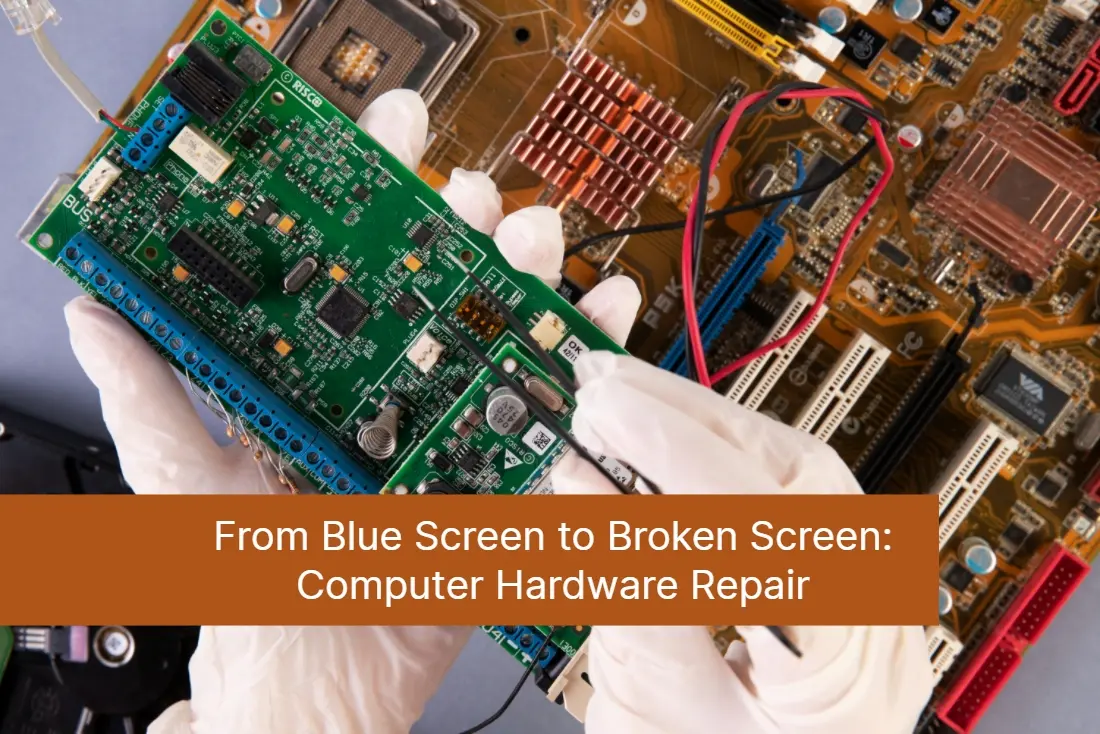
17 Jul From Blue Screens to Broken Screens: A Comprehensive Guide to Computer Hardware Repair
Computers are an integral part of our daily lives, and when they break down, it can be incredibly frustrating. From blue screens of death to broken screens, computer hardware problems can wreak havoc on our productivity. But fear not, as a comprehensive guide to computer hardware repair is here to help. Whether you’re a novice or a seasoned professional, this guide will provide you with the knowledge and tools you need to troubleshoot and repair your computer hardware issues. From diagnosing the problem to replacing parts, we’ll cover everything you need to know to get your computer up and running in no time. So, grab your toolkit and join us on this journey to becoming a computer hardware repair expert
Common hardware issues
There are several common hardware issues that can cause your computer to malfunction. One of the most common problems is the blue screen of death. This error message appears when your computer encounters a problem that it cannot recover from. Other common hardware issues include broken screens, malfunctioning hard drives, faulty motherboards, and damaged power supply units.
A broken screen is another common hardware issue. This can happen due to accidental drops or mishandling of the device. A broken screen can make it difficult to use your computer, and it can also be a safety hazard if the screen is cracked. It’s important to get your screen repaired as soon as possible to avoid further damage to your device.
Malfunctioning hard drives can also cause various issues with your computer. Symptoms of a failing hard drive include slow performance, frequent crashes, and error messages when you try to access files. If you suspect that your hard drive is failing, it’s important to back up your data immediately and replace the hard drive as soon as possible.
For all of your computer repair needs in Fort Lauderdale, choose Downtown Computer Services
.In our repair shop, our computer repair technician is prepared to carry out free computer diagnostics and repairs. Call us right away at (954) 524 9002 or fill out the form below to request a repair.
Tools needed for computer hardware repair
To repair your computer hardware, you’ll need a few essential tools. These include a set of screwdrivers, pliers, a multimeter, a soldering iron, thermal paste, and a grounding strap. It’s also a good idea to have a spare set of screws and cables in case you need to replace any parts.
A set of screwdrivers is essential for opening up your computer and accessing its components. Pliers can be used to remove cables and connectors, while a multimeter can help you test for electrical continuity. A soldering iron can be used to repair broken connections on a circuit board, while thermal paste is necessary for replacing the heat sink on your processor. Finally, a grounding strap is essential for preventing electrostatic discharge during repairs.
Troubleshooting hardware issues
Before you start replacing hardware components, it’s important to troubleshoot the issue to determine the root cause of the problem. This will help you avoid unnecessary repairs and save time and money. One of the first things you should do is check for error messages or warning signs on your computer. This can help you identify the type of hardware issue you’re dealing with.
If you’re experiencing a blue screen of death, your computer may be experiencing a software issue. You can try booting your computer in safe mode to see if the problem persists. If you’re still experiencing issues, you may need to reinstall your operating system or update your drivers.
If you’re experiencing a hardware issue, you can try running diagnostic tests to identify the problem. Most computer manufacturers provide diagnostic tools that can help you identify hardware issues. You can also try running a memory test or a hard drive diagnostic test to identify any issues.
How to replace a hard drive
Replacing a hard drive is a relatively simple process that can be done by most computer users. The first step is to back up your data to an external hard drive or cloud storage. Once you’ve backed up your data, turn off your computer and unplug it from the power source. Open up your computer case and locate the hard drive.
Remove the screws that hold the hard drive in place and disconnect the cables and connectors. Carefully remove the hard drive from the case and disconnect it from its mounting bracket. Install the new hard drive by reversing the steps you took to remove the old one. Be sure to reconnect all cables and connectors and secure the hard drive with screws.
How to replace RAM
Replacing RAM is another simple process that can be done by most computer users. The first step is to turn off your computer and unplug it from the power source. Locate your RAM slots on your motherboard. Press down on the clips on either side of the RAM module to release it from the slot.
Remove the old RAM module and replace it with the new one. Make sure that the notches on the RAM module are aligned with the notches on the slot. Press down firmly on the module until you hear a click. Repeat this process for any additional RAM modules.
How to replace a motherboard
Replacing a motherboard is a more complicated process that should only be attempted by experienced users. Before you start, back up your data and ensure that you have all the necessary tools. The first step is to turn off your computer and unplug it from the power source. Open up your computer case and locate the motherboard.
Disconnect all cables and connectors from the motherboard. Remove any screws or brackets that hold the motherboard in place. Carefully remove the motherboard from the case and replace it with the new one. Be sure to reconnect all cables and connectors and secure the motherboard with screws.
How to replace a graphics card
Replacing a graphics card is a relatively simple process that can improve your computer’s performance. The first step is to turn off your computer and unplug it from the power source. Open up your computer case and locate the graphics card.
Remove any screws or brackets that hold the graphics card in place. Carefully remove the graphics card from the slot and disconnect any cables or connectors. Install the new graphics card by reversing the steps you took to remove the old one. Be sure to reconnect all cables and connectors and secure the graphics card with screws.
How to replace a power supply unit
Replacing a power supply unit is a more complicated process that should only be attempted by experienced users. The first step is to turn off your computer and unplug it from the power source. Open up your computer case and locate the power supply unit.
Disconnect all cables and connectors from the power supply unit. Remove any screws or brackets that hold the power supply unit in place. Carefully remove the power supply unit from the case and replace it with the new one. Be sure to reconnect all cables and connectors and secure the power supply unit with screws.
Tips for preventing hardware issues
Preventing hardware issues is essential for keeping your computer running smoothly. One of the best ways to prevent issues is to keep your computer clean and dust-free. Dust can clog up fans and vents, causing your computer to overheat. You should also avoid exposing your computer to extreme temperatures or humidity.
Regularly backing up your data can also help prevent hardware issues. If your hard drive fails, you can rest easy knowing that your data is safe and sound. Finally, make sure to keep your computer up to date with the latest software updates and security patches. This can help prevent software issues and keep your computer running smoothly.
Conclusion
In conclusion, computer hardware issues can be frustrating, but they don’t have to be. By following this comprehensive guide to computer hardware repair you can troubleshoot and repair common hardware issues quickly and easily. From replacing a hard drive to upgrading your graphics card, this guide has everything you need to become a computer hardware repair expert. So, grab your toolkit and get started today!
If you find it difficult to repair hardware, please contact our computer technicians for help.
Downtown Computer Services offers computer repair, hardware upgrade, or computer hardware replacement. Call us at (954) 524 9002 or apply online.
Check out other relevant news
- How Easy-to-Use Hacking Tools Are Fueling Cybercrime
- Cryptocurrency Security for Small Businesses: Protecting Your Wallet
- The Infostealer Epidemic: Protecting Your Business from the Latest Wave of Cyberattacks
- The Identity Crisis: How Compromised Credentials Can Cripple Your Business
- Beyond the Brick and Mortar: Building Your Online Storefront with Digital Marketing
